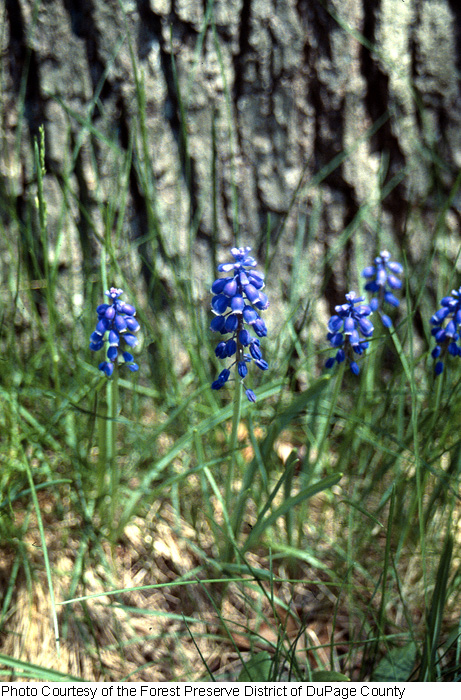Muscari
|
Family: Asparagaceae |
Herbs perennial, scapose, from brown, tunicate, ovoid bulbs, with or without offsets (bulblets). Leaves (1-)2-7, basal; blade linear, sometimes sulcate, glabrous, rather fleshy. Scape terete. Inflorescences terminally racemose, many-flowered, dense, bracteate, usually elongating in fruit; distal flowers smaller, sterile, differing in color, forming a tuft (coma); bracts minute. Flowers fragrant; perianth tubular to urceolate, usually constricted basally; tepals 6, connate most of their length, distal portions distinct, reflexed, short, toothlike; stamens 6, epitepalous, in 2 rows, included; anthers dark blue, dorsifixed, globose; ovary superior, green, 3-locular, inner sepal nectaries present; style 1; stigma 3-lobed. Fruits capsular, obtusely 3-angled, papery, dehiscence loculicidal. Seeds 6, black, globose, wrinkled to reticulate. x = 9. Various species and cultivated forms of Muscari are commonly grown for their early spring flowers. They may reseed in the flora area, but they are mostly transported in soil containing the bulblets. Muscari armeniacum Baker has been attributed to the flora, but no definite records of naturalized plants have been found. Herbarium specimens of that species are difficult to distinguish from those of M. neglectum, but live specimens of M. armeniacum have much paler blue flowers (A. Huxley et al. 1992).
Perianth tubular or urceolate, shortly 6-toothed; stamens 6, inserted on the perianth-tube, included; stigma 1; fr a loculicidal capsule, distinctly 3- angled or almost winged; seeds angular; perennial herbs from a coated bulb, the linear lvs basal, the short erect scape bearing a dense raceme in the spring. 60, Europe, Medit. reg., w. Asia. Gleason, Henry A. & Cronquist, Arthur J. 1991. Manual of vascular plants of northeastern United States and adjacent Canada. lxxv + 910 pp. ©The New York Botanical Garden. All rights reserved. Used by permission. |

